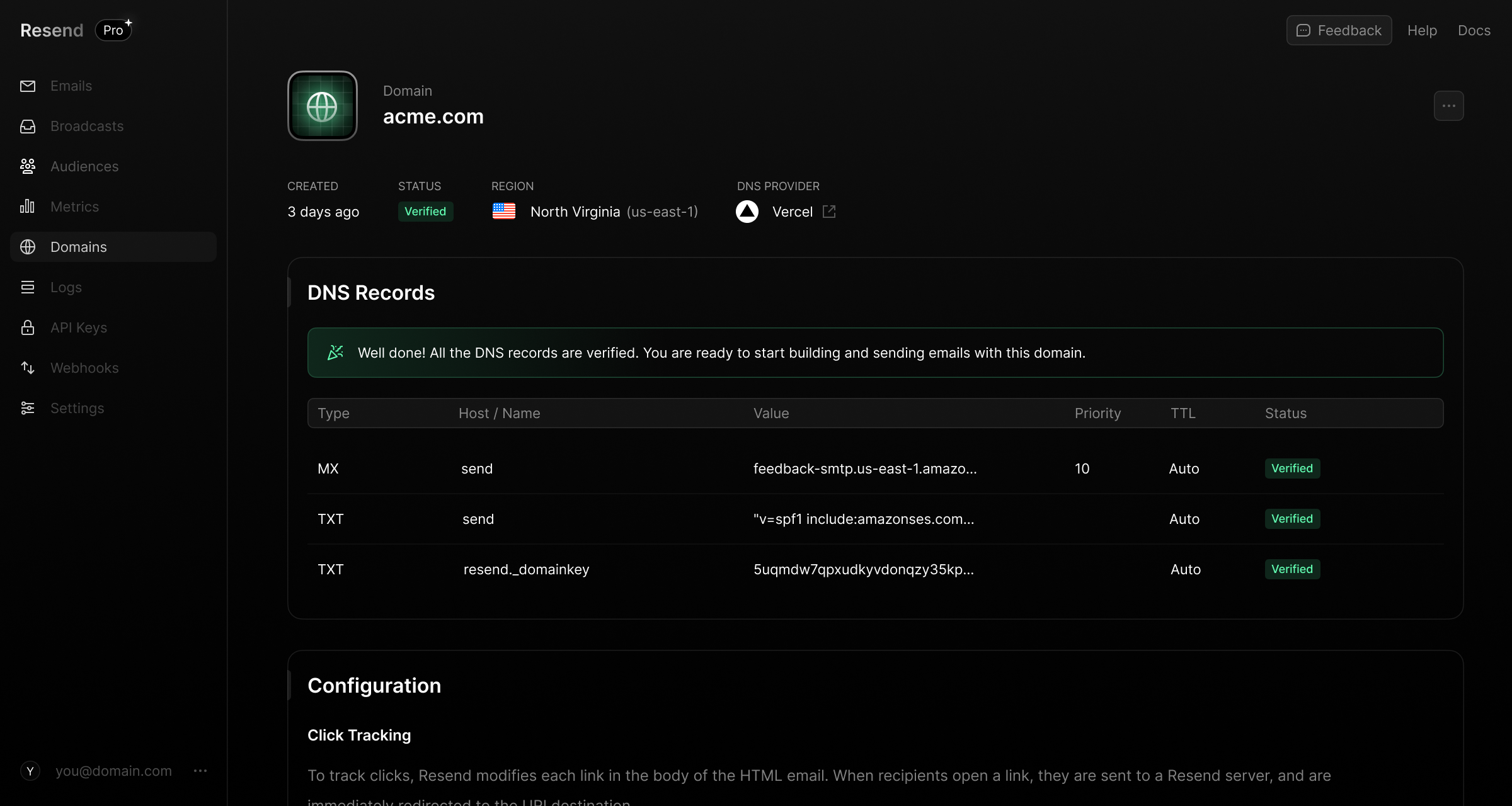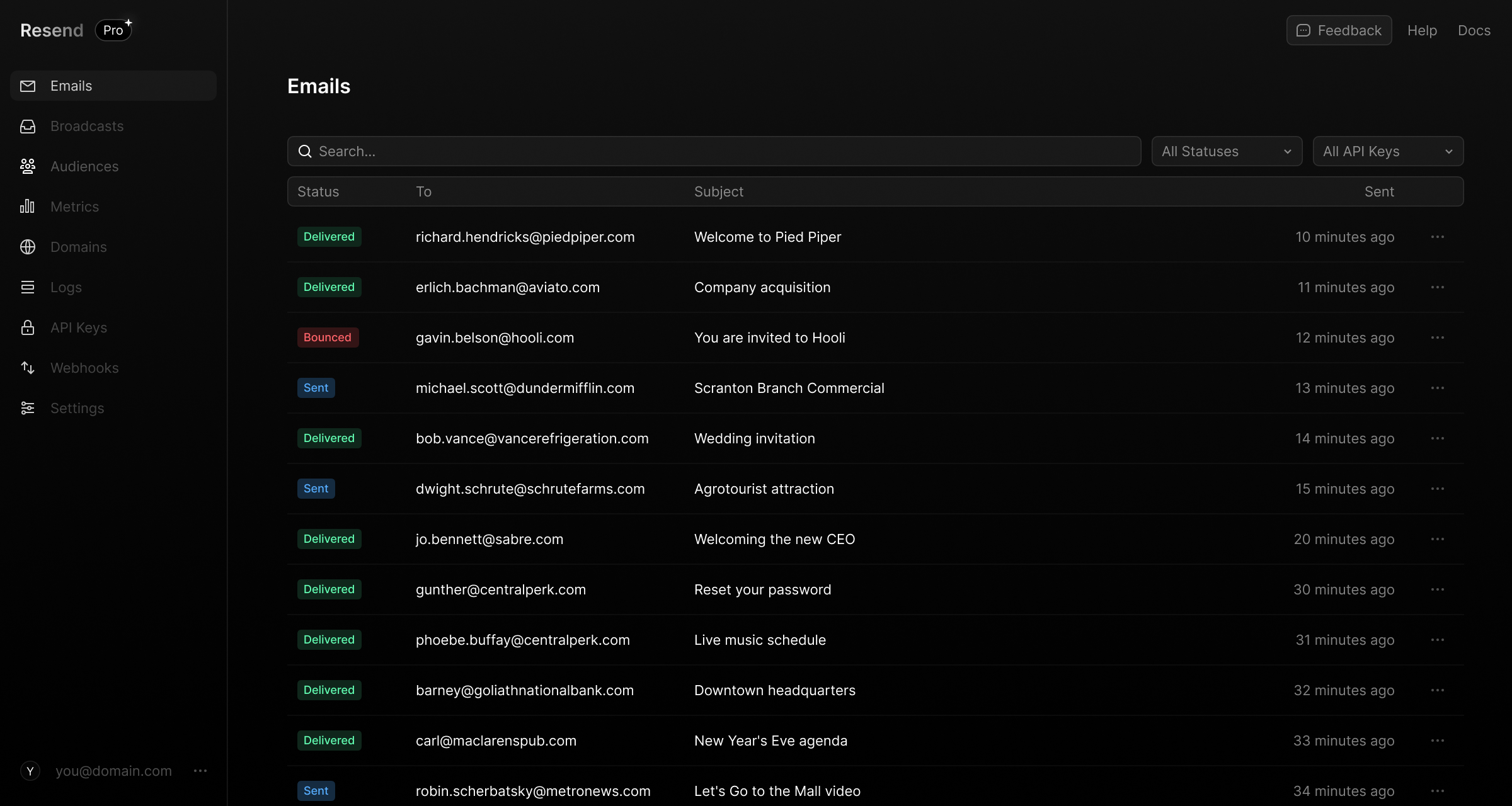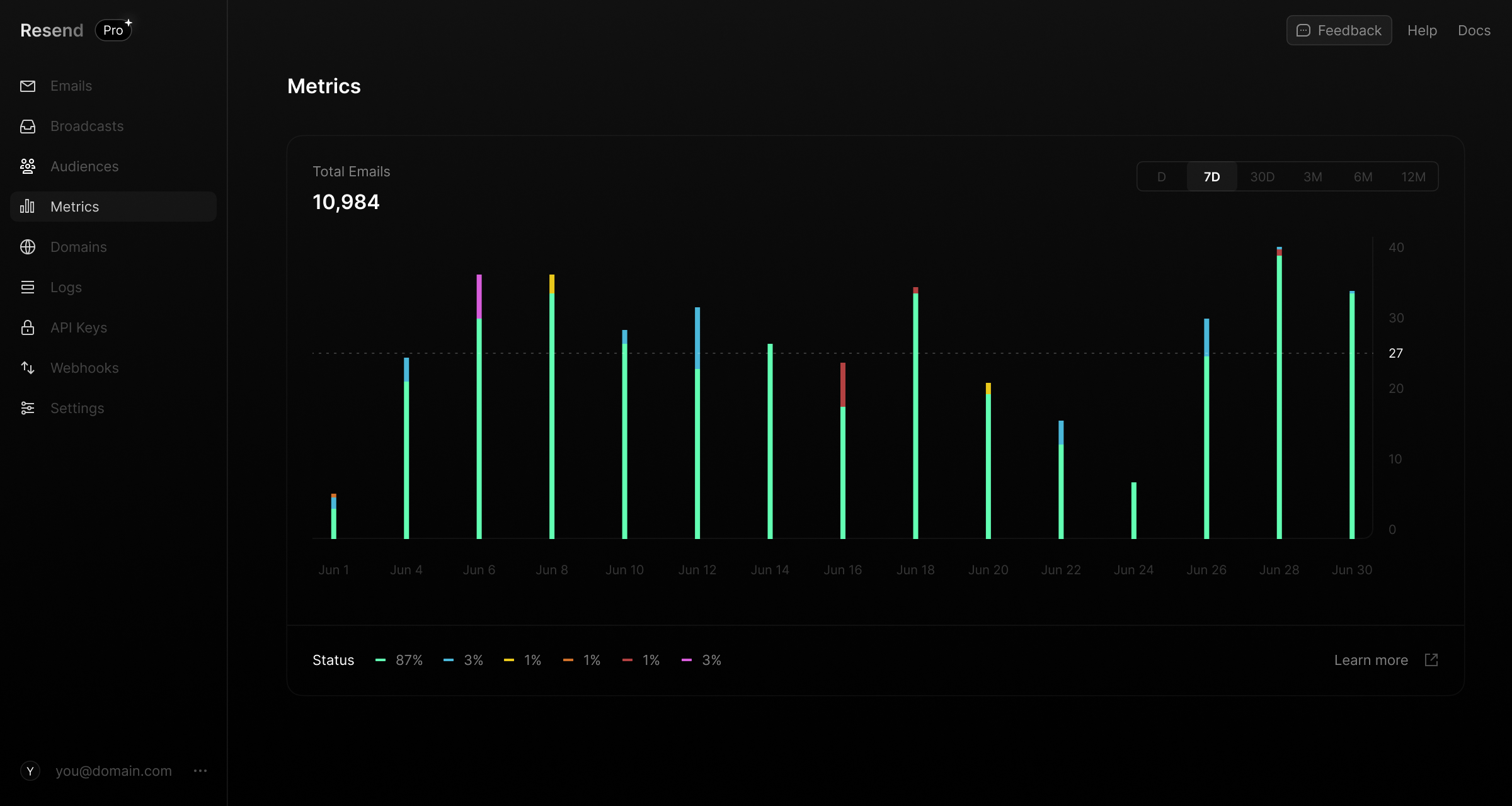
Migrating from
Mailgun to Resend
Introduction
If you're considering migrating from Mailgun to Resend, you're in the right place.
This guide will help you understand the key differences between the two services and provide you with the necessary steps to make the transition as smooth as possible.
Jump ahead
- History
- Concepts
- Official SDKs
- Send email via API
- Send email via SMTP
- Webhooks
- Security & Privacy
- Idempotency Keys
- Additional Features
- Pricing
- Conclusion
History
Mailgun and Resend are both email delivery services, but they have different histories and focuses.
Key differences
- Mailgun was founded in 2010. In September 2021, Sinch acquired Mailgun.
- Resend was founded in 2023. Resend has a focus on providing a modern developer experience.
Concepts
Both Mailgun and Resend provide user-friendly dashboards for managing your email sending.
Domains
In Mailgun and Resend you need to access the Domains page to verify your domain.

Both Mailgun and Resend offer similar authentication features.
| Name | Mailgun | Resend |
|---|---|---|
| DKIM | DKIM enforced | DKIM enforced |
| SPF | SPF enforced | SPF enforced |
| DMARC | DMARC not displayed | DMARC recommended |
Activity Feed
When you send email through Mailgun, sent email is visible on the Dashboard page.
When you send email with Resend, emails are visible on the Emails page.

Dashboard
Mailgun shows sending statistics on the Reporting page.
In Resend, statistics are shown on the Metrics page.

Official SDKs
Both Mailgun and Resend provide official SDKs for various programming languages, making them easy to integrate into your application.
Key differences
- Mailgun does not have official SDKs for Python, Rust, or .NET.
| Platform | Mailgun | Resend |
|---|---|---|
| Node.js | mailgun.js | resend-node |
| PHP | mailgun-php | resend-php |
| Python | - | resend-python |
| Ruby | mailgun-ruby | resend-ruby |
| Go | mailgun-go | resend-go |
| Rust | - | resend-rust |
| Java | mailgun-java | resend-java |
| .NET | - | resend-dotnet |
Send email via API
Both Mailgun and Resend provide a REST API (HTTP) and SDKs for sending emails programmatically.
Key differences
- Mailgun allows for sending emails as a Template (see docs).
- Mailgun has a maximum size of 25 MB (see docs).
- Resend has a maxiumum size of 40 MB (see docs).
Mailgun
const formData = require('form-data');const Mailgun = require('mailgun.js');const mailgun = new Mailgun(formData);const mg = mailgun.client({username: 'api', key: process.env.MAILGUN_API_KEY || 'key-yourkeyhere'});mg.messages.create('sandbox-123.mailgun.org', {from: "Excited User <mailgun@sandbox-123.mailgun.org>",to: ["test@example.com"],subject: "hello world",text: "Testing some Mailgun awesomness!",html: "<h1>Testing some Mailgun awesomness!</h1>"}).then(msg => console.log(msg)).catch(err => console.error(err));
Resend
import { Resend } from 'resend';const resend = new Resend('re_xxxxxxxxx');await resend.emails.send({from: 'Acme <onboarding@resend.dev>',to: ['delivered@resend.dev'],subject: 'hello world',html: '<p>it works!</p>',});
Send email via SMTP
Both Mailgun and Resend support sending emails via SMTP.
SMTP stands for Simple Mail Transfer Protocol. It is a text-based protocol in which one server communicates with another to send an email.
Key differences
Configurations
- Mailgun allows for the passing of sending options, like Tags in the SMTP headers (see docs)
- Mailgun offers the ability to private label the use of Mailgun at an SMTP level via a CNAME record (see docs)
- Mailgun allows for the creation of a Username and Password based on the domain (see docs).
- Resend uses a standard value for the Username and the API Key as the Password (see docs).
| Configuration | Mailgun | Resend |
|---|---|---|
| Host | `smtp.mailgun.org` | `smtp.resend.com` |
| Port | 25, 2525, 587, or 465 | 25, 465, 587, 2465, or 2587 |
| Username | The created username | The '`resend`' string |
| Password | The created password | Resend API key |
| Authentication | Plain text (unencrypted), STARTTLS | SMTPS or STARTTLS |
Webhooks
Both Mailgun and Resend provide webhooks to notify your application of email events.
Key differences
- Mailgun has a category called Failure, which happens when emails have both a hard and a soft bounce.
- Resend has logs of webhook requests, allowing you to see the status of your webhook responses (see docs).
| Event | Mailgun | Resend |
|---|---|---|
| Inbound | Inbound | Inbound |
| Send | - | email.sent |
| Delivery | delivered | email.delivered |
| Delivery Delayed | temporary_fail | email.delivery_delayed |
| Bounces | permanent_fail | email.bounced |
| Complaints | complained | email.complained |
| Open Tracking | opened | email.opened |
| Click Tracking | clicked | email.clicked |
| Unsubscribe | unsubscribed | contact.updated |
Security & Privacy
Mailgun and Resend both have robust and similar security features.
Key differences
- Mailgun is HIPAA compliant.
- Mailgun does not offer Google, or GitHub as authentication methods, while Resend does.
| Name | Mailgun | Resend |
|---|---|---|
| Authentication | Email/Password | Email/Password, Google, GitHub |
| Multi-Factor Auth | MFA available | MFA available |
| GDPR | GDPR compliant | GDPR compliant |
| SOC 2 | SOC 2 compliant | SOC 2 compliant |
| HIPAA | HIPAA compliant | - |
Idempotency Keys
Resend supports idempotency keys on the POST /emails and POST /emails/batch endpoints.
Mailgun does not currently support idempotency keys.
An idempotent operation is an action you can perform more than once, with the same input, and it always produces the same outcome and avoids repeating side effects.
By adding an Idempotency-Key header, or using the equivalent field on our SDKs, you can tell Resend that this specific email should only be sent once, even if we get more than one request from you about it.
POST /emails
await resend.emails.send({from: 'Acme <onboarding@resend.dev>',to: ['delivered@resend.dev'],subject: 'hello world',html: '<p>it works!</p>',},{idempotencyKey: 'welcome-user/123456789',},);
POST /emails/batch
import { Resend } from 'resend';const resend = new Resend('re_xxxxxxxxx');await resend.batch.send([{from: 'Acme <onboarding@resend.dev>',to: ['foo@gmail.com'],subject: 'hello world',html: '<h1>it works!</h1>',},{from: 'Acme <onboarding@resend.dev>',to: ['bar@outlook.com'],subject: 'world hello',html: '<p>it works!</p>',},],{idempotencyKey: 'team-quota/123456789',},);
Adding idempotency keys not only helps you avoid sending duplicate emails and using up your quota, but also enables building more robust and scalable systems.

Idempotency Keys
Learn how to send an idempotent email using Resend.
https://resend.com/docs/dashboard/emails/idempotency-keys
Additional Features
Outside of core email sending, Resend offers additional features that Mailgun does not have that may be helpful for you.
No-code editor
The no-code editor makes it easy for anyone to write, format, and send broadcast emails.

Send Marketing Emails with Resend Broadcasts
Enabling anyone to send email campaigns without code.
resend.com/blog/send-marketing-emails-with-resend-broadcasts
Multi-Region
Improve your email deliverability speed by using a region nearest to your users, with options beyond the US and EU.

Faster Email Delivery with Multi-Region
Faster deliverability with reduced latency.
resend.com/blog/multi-region
Pricing
Mailgun and Resend offer competitive pricing based on the number of emails sent.
Key differences
- Mailgun requires the Scale plan for Dedicated IP usage.
| Emails | Mailgun | Resend |
|---|---|---|
| 3,000 | $0 | $0 |
| 50,000 | $35 | $20 |
| 100,000 | $75 | $35 |
| 200,000 | $215 | $160 |
| 500,000 | $400 | $350 |
| 1,000,000 | $700 | $650 |
| 1,500,000 | $1,250 | $1,250 |
Conclusion
Ready to migrate to Resend? Press S to get started. If there's anything else we can help with, contact our team, and we'll answer any questions you have.